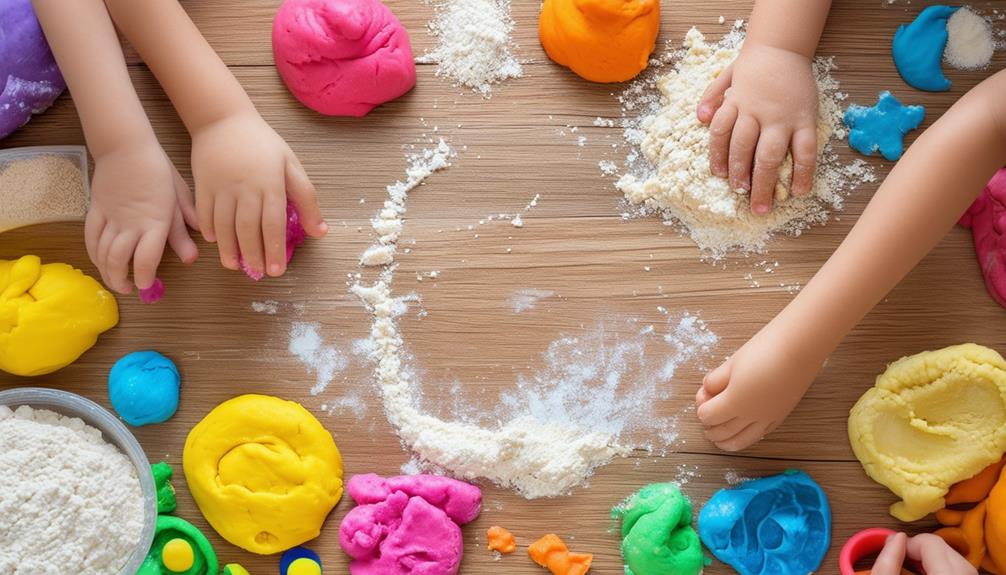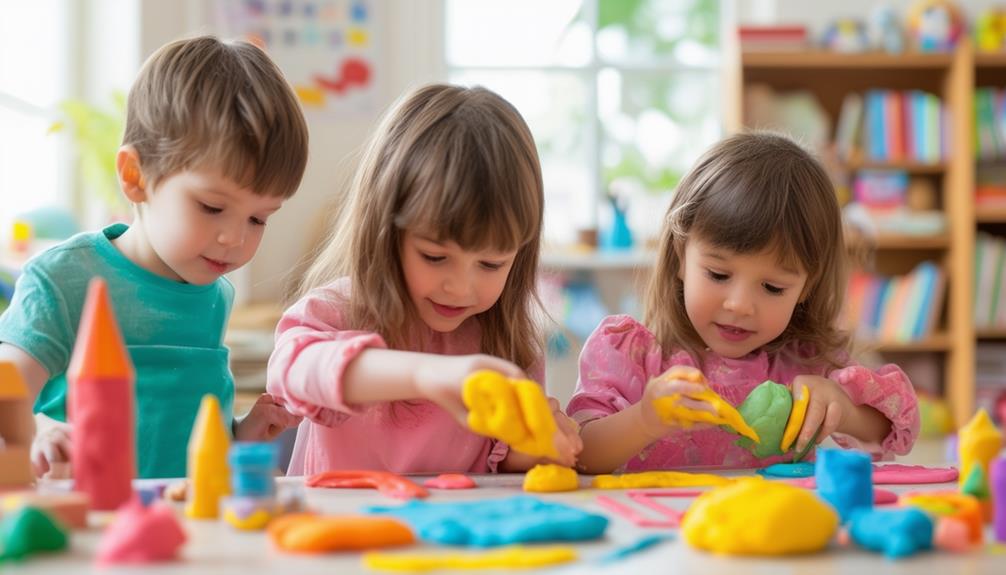Why Is Homemade Playdough Better?

Making playdough at home allows you to control every ingredient, ensuring it's safe and free from harmful chemicals. This protects your children's health and lets you customize colors and textures. Additionally, homemade playdough is cost-effective, often using simple kitchen staples. Beyond these benefits, this activity can strengthen family bonds and foster creativity. Let's delve deeper into why homemade playdough is the better choice for your family.
Customizable Ingredients

One of the biggest benefits of homemade playdough is the ability to customize the ingredients to fit your specific needs, making it a more personalized and enjoyable experience. For instance, if someone in your family has dietary restrictions, you can substitute traditional cream of tartar with baking soda or vinegar.
Selecting non-toxic and eco-friendly ingredients is another significant advantage. Unlike some commercial brands that may contain unregulated elements, homemade playdough allows you to choose safe components, ensuring a worry-free playtime. By adding natural colorings like Kool-Aid or beet juice, you can avoid artificial dyes, catering to individual preferences and sensitivities.
You can also enhance sensory play by incorporating essential oils or extracts, introducing unique scents without synthetic fragrances. The flexibility of a homemade playdough recipe means you can adapt it to accommodate allergies or sensitivities, such as using gluten-free flour. This inclusivity ensures all children can enjoy the fun without any concerns.
With customizable ingredients, you're in control, making playdough that's not only fun but also safe and tailored to your family's needs.
Safety and Non-Toxicity
When you make playdough at home using common household ingredients like flour, water, and salt, you ensure it is free from harmful chemicals often found in commercial products. This non-toxic formulation means your children are safer and less exposed to unregulated substances. Additionally, you can customize the ingredients to avoid allergens, providing you with peace of mind.
Chemical-Free Ingredients
Making playdough at home ensures you're avoiding harmful chemicals. When you choose homemade playdough, you use simple, chemical-free ingredients like flour, water, salt, and cream of tartar, resulting in a non-toxic product safe for your children. Unlike commercial brands that often contain preservatives and artificial colors, homemade versions allow you to use natural colorings like Kool-Aid or food coloring, further reducing chemical exposure.
By making your own playdough, you control its ingredients, allowing you to avoid allergens or harmful additives that might be present in store-bought options. This control provides peace of mind, knowing exactly what your kids are handling and playing with.
The simplicity of homemade playdough makes it not only a safer choice but also ideal for sensory play. You can be assured that your children are having fun without the risk of exposure to unknown or unregulated substances. In conclusion, the chemical-free ingredients of homemade playdough make it a superior, safer option for your kids' playtime activities.
Child-Safe Formulation
Homemade playdough's child-safe formulation offers an added layer of security due to its use of common, non-toxic household ingredients like flour, salt, and water. Unlike some commercial brands that may contain unregulated chemicals, homemade playdough eliminates the risk of harmful additives, making it a safer choice, especially for young children who might be tempted to taste their creations.
Additionally, homemade playdough allows for customization with safe coloring and scent alternatives. You can use food coloring and essential oils, ensuring that playtime is both enjoyable and safe. This customization not only enhances the play experience but also guarantees that your child isn't exposed to potentially harmful substances.
While regular supervision is essential, the non-toxic nature of homemade playdough means you can let your child explore and create without constant worry about health risks. It's a win-win situation: your child gets to engage in creative play, and you enjoy the peace of mind that comes with knowing they're playing with something truly safe. So, give homemade playdough a try and experience the safety and joy it brings.
Allergy Considerations
Homemade playdough, made from basic household ingredients like flour, salt, and water, is a safer alternative to commercial options, which often contain harmful chemicals. This is especially important for children prone to allergies.
By making your own playdough, you can control the ingredients, ensuring it's free of common allergens such as gluten, dairy, and artificial colorants. This customization reduces the risk of allergic reactions, making playtime safer and more inclusive. Additionally, using natural food coloring avoids synthetic dyes that can trigger sensitivities in some children.
Homemade playdough is non-toxic, free from preservatives and additives found in store-bought versions. This makes it an excellent choice for parents who want to ensure their children are playing with the safest materials possible.
To make the most of your homemade playdough:
- Store properly: Keep it in an airtight container to prevent mold and spoilage.
- Monitor regularly: Check for any signs of spoilage before each play session.
- Customize: Use natural food coloring and scents for a safe, personalized experience.
Cost-Effectiveness

Creating homemade playdough is a more cost-effective option compared to purchasing commercial alternatives. Making playdough at home costs approximately $2 to $3 per batch. In contrast, store-bought playdough typically costs around $5 or more per container. A single homemade batch yields nearly 2 cups, which is equivalent to the amount found in four standard store-bought containers, offering better value for your money.
The ingredients needed to make playdough—flour, salt, and water—are common household items, making it an affordable option. You likely already have these basics in your pantry, further reducing costs. Additionally, homemade playdough can last over a year if stored properly, minimizing the need for frequent replacements and saving money over time.
Educational Value
Homemade playdough offers numerous educational benefits that extend beyond mere play. Engaging in the creation of playdough provides a hands-on activity that enhances sensory experiences and stimulates imaginative play, crucial for cognitive development in children aged 2 to 8 years. The process of measuring and mixing ingredients is not only enjoyable but also teaches basic math concepts and improves fine motor skills through the manipulation of the dough.
Forming shapes and figures from playdough enhances spatial awareness and problem-solving skills as your child explores different designs and structures. Following a recipe to make playdough also develops listening and comprehension skills, which are essential for early literacy. Furthermore, playdough activities promote teamwork and social interaction, aiding in the development of fundamental communication skills.
To maximize the educational value of homemade playdough, consider the following tips:
- Incorporate Counting: Count the ingredients and shapes together to reinforce math skills.
- Discuss Colors and Textures: Talk about the colors and textures while mixing and playing to expand sensory vocabulary.
- Create Story Scenarios: Use playdough figures in storytelling to boost creativity and narrative skills.
Family Bonding
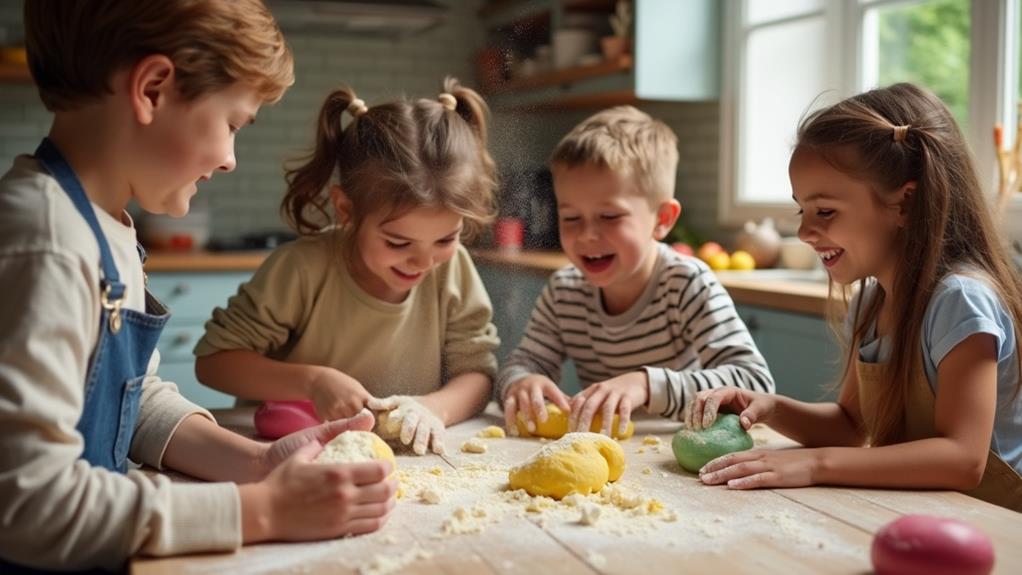
Gathering around the kitchen to make homemade playdough is a fantastic way to strengthen family bonds. Collaborating on this simple project allows everyone to contribute, fostering teamwork and communication skills. The activity itself becomes an engaging and quality time together, enhancing connections and creating lasting memories.
Customizing your playdough with different colors and scents adds a unique, personalized touch to your creative playtime. Each family member can suggest their favorite colors or fragrances, making the experience more special. This customization encourages participation and idea-sharing, reinforcing a sense of belonging and unity.
Once your homemade playdough is ready, the fun continues. Engaging in imaginative play with your creations can lead to delightful role-playing scenarios, such as crafting a pretend bakery or sculpting animals for a mini-zoo. These activities promote shared storytelling, strengthening relationships through collective creativity and fun.
Ultimately, homemade playdough sessions often lead to laughter and joy, reinforcing positive family dynamics. The shared experiences and emotional connections formed during this creative playtime are invaluable. By making and playing with homemade playdough, you're building a foundation of love and togetherness.
Sensory Experience
When your child plays with homemade playdough, they enhance their tactile exploration through its customizable texture. Adding colors, scents, and different textures engages multiple senses, creating a rich sensory experience. This multi-sensory engagement not only improves fine motor skills but also provides a soothing and enjoyable activity, especially beneficial for children with sensory sensitivities.
Enhances Tactile Exploration
Engaging with homemade playdough provides children a unique tactile experience that stimulates sensory investigation. The soft, pliable texture encourages kids to explore various shapes and forms using their hands. This hands-on activity improves sensory engagement as they stretch, roll, and squish the dough, fostering a rich tactile experience.
The pliability of homemade playdough supports a wide range of manipulative play essential for developing fine motor skills. As children knead and shape the dough, they build hand strength and dexterity, supporting their physical development and providing a satisfying sensory experience.
One significant advantage of homemade playdough is the ability to customize its texture and consistency. Tailoring it to your child's preferences makes the sensory experience more engaging and enjoyable. Customization can also create a calming and therapeutic outlet, reducing anxiety and improving focus.
- Tips to Improve Tactile Exploration:
- Experiment with different textures by adding rice or sand to the dough.
- Use tools like rolling pins and cookie cutters to create various shapes.
- Encourage imaginative play by incorporating small toys or natural elements like leaves.
These activities make tactile exploration with homemade playdough a fun and beneficial experience for children.
Engages Multiple Senses
Creating homemade playdough engages multiple senses, offering a rich sensory experience for children. When kids feel the soft, squishy texture, they immerse themselves in tactile exploration, enhancing their sensory perception. The hands-on activity of measuring and mixing ingredients introduces auditory experiences through the sounds of stirring and kneading, further promoting hands-on learning. Adding food coloring or glitter creates a lively visual feast, encouraging children to experiment with colors and design their own visually appealing creations.
Incorporating different scents, such as essential oils or flavored extracts, adds another layer to the sensory experience by stimulating their sense of smell. Imagine the joy of playing with lavender-scented playdough or the excitement of a peppermint aroma filling the room. These olfactory dimensions make the play even more engaging and enjoyable.
Additionally, the act of manipulating and molding the playdough fosters fine motor skill development. Children strengthen their hand muscles and improve coordination as they shape and create. The comprehensive sensory experience of homemade playdough is unmatched, offering a multi-dimensional activity that stimulates sight, sound, smell, and touch, all while contributing to vital developmental skills.
Long-Lasting Use
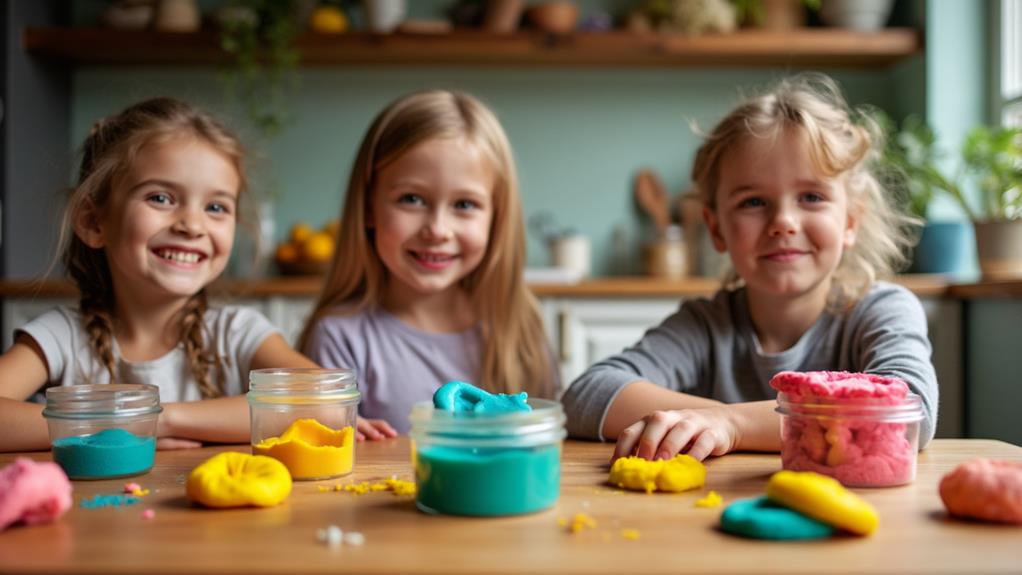
Homemade playdough can offer long-lasting use, often outlasting commercial versions when properly cared for and stored. By keeping it in airtight containers, such as Ziploc bags, homemade playdough can remain usable for over a year, making it a cost-effective and durable option. Unlike store-bought playdough, which tends to dry out quickly, homemade versions retain their soft and pliable texture if stored correctly.
Proper storage is crucial. After the playdough has cooled, ensure it is kept in airtight containers to prevent mold and spoilage, maintaining the right consistency for extended periods of play. High humidity can affect its longevity, but you can adjust the recipe to maintain its quality.
Regular checks for consistency and smell will help gauge its freshness. If it starts to dry out, adding a few drops of water can restore its texture. To ensure your homemade playdough lasts:
- Store in airtight containers: Use Ziploc bags or sealed plastic containers.
- Adjust for humidity: Modify the recipe based on the climate conditions.
- Regularly check for freshness: Inspect for any changes in texture or smell.
Creative Play
Homemade playdough offers a world of creative possibilities, allowing you to customize colors, textures, and scents to inspire imaginative play. This flexibility enables you to tailor the playdough for any activity, enhancing your child's artistic expression. By making playdough at home, you're crafting a versatile tool that can transform into anything from a vibrant garden to a spooky Halloween scene. This customization encourages children to think creatively, molding and shaping their unique designs directly from their imagination.
Engaging in creative play with homemade playdough does more than just entertain; it promotes fine motor skills and cognitive development. Whether your child is forming letters, creating animal shapes, or building intricate structures, they are learning and growing. Additionally, the process of making playdough together fosters collaborative creativity. Brainstorming colors, scents, and themes can turn a simple activity into a family bonding experience.
Homemade playdough can be adapted for themed activities, making it an excellent resource for both fun and educational purposes. Whether it's seasonal crafts or learning about different animals, the possibilities are endless. So, dive into the world of homemade playdough and watch your child's creativity flourish.
Easy Storage
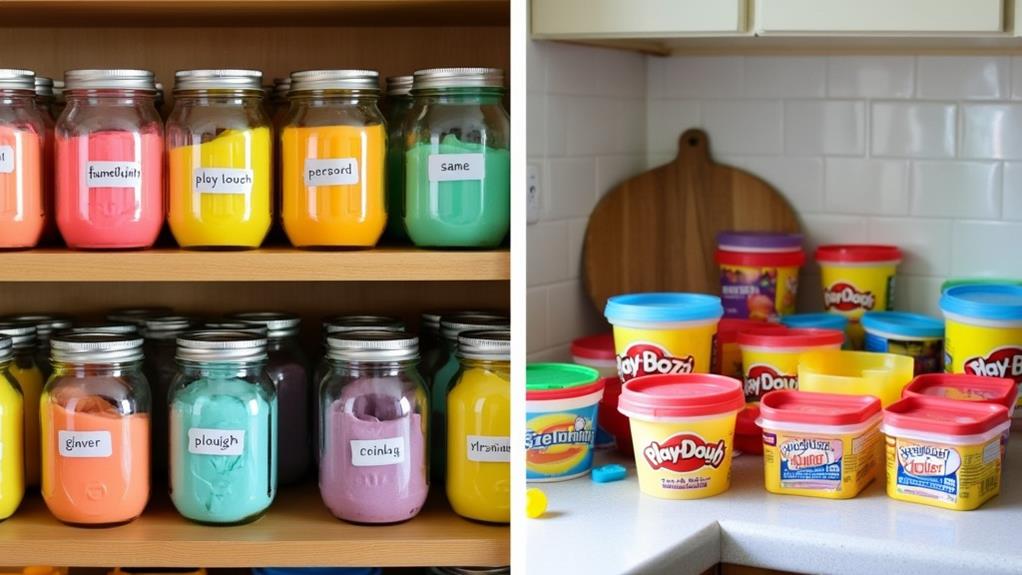
Storing homemade playdough is simple with quart-sized zip-top bags, which keep it soft and usable for up to three months. Proper sealing prevents mold, ensuring it's safe for kids. Compact storage saves space and makes clean-up quick and easy.
Long-Term Usability
To ensure your homemade playdough lasts for months, proper storage is essential. Using quart-sized zip-top bags will keep it airtight and maintain its softness, making it ready for play anytime. This storage method supports long-term usability. Typically, the recipe yields about 2 cups of playdough, which is equivalent to approximately four standard store-bought containers, making it a cost-effective option, especially for group activities.
Proper storage involves more than just using the right bags. You should also keep the playdough in a cool, dry place to maintain its texture and prevent spoilage. Regularly checking the playdough for signs of mold or any changes in texture will ensure it remains safe and enjoyable for children.
Here are some tips to maximize the lifespan of your homemade playdough:
- Use quart-sized zip-top bags: These keep the playdough airtight.
- Store in a cool, dry place: Avoid areas with high humidity and temperature fluctuations.
- Check regularly: Inspect for mold or changes in texture to ensure the playdough remains safe and fresh.
Mold Prevention Techniques
Preventing mold in your homemade playdough hinges on proper storage techniques. Begin by storing your playdough in quart-sized zip-top bags, which help maintain its softness and prevent exposure to air that can cause drying or mold growth. Ensure the playdough is completely cool before sealing it in the storage bags; if sealed while warm, trapped moisture can encourage mold development.
Incorporating cream of tartar into your playdough recipe is another effective mold prevention method. This ingredient not only enhances texture but also acts as a natural preservative, extending the playdough's shelf life. Regularly inspect your stored playdough for any signs of mold or spoilage. If you detect changes in texture or smell, discard it to ensure safe play.
Always store your homemade playdough in a cool, dry place. High humidity can adversely affect its consistency and increase the risk of mold formation. By adhering to these straightforward steps, you can ensure longer-lasting, mold-free homemade playdough, ready for endless fun.
Community Feedback
Homemade playdough often elicits enthusiastic feedback for its ability to spark joy and creativity. Parents and caregivers frequently praise its role in helping children develop creativity and strengthen family bonds. The simplicity of the recipe encourages repeated use and sharing among families, making it a regular and enjoyable educational activity.
Many users express nostalgic joy, recalling their own childhood experiences with playdough and now passing this timeless activity on to their children. This generational connection adds an extra layer of warmth to the experience. Customizing playdough with unique colors, scents, and textures enhances the play experience and further ignites creativity in kids.
The community is remarkably supportive, sharing tips and tricks to address common issues like stickiness or dryness. This collective wisdom ensures that everyone can enjoy a successful playdough-making experience.
- Engage in a creative activity that fosters bonding
- Customize with unique colors and scents for added fun
- Benefit from a supportive community that shares valuable tips
Homemade playdough truly brings families together in a fun and creative way.


